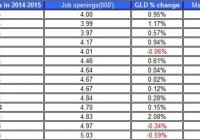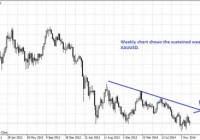The U.S. Economy Recovers – GLD Comes Down
The non-farm payroll brought down GLD. Rising long-term treasury yields are keeping down GLD. It’s still uncertain where the demand for gold in China and India is heading. The recovery of the SPDR Gold Trust (NYSEARCA: GLD ) came to a halt in recent weeks as the recent economic indicators, mainly in the U.S. labor market, were better than anticipated. Let’s review the latest from the U.S. economy and its relation to the progress of GLD. The two major labor reports are the non-farm payroll and JOLTS. The non-farm payroll presented better-than-expected results. The JOLTS report was in line with market expectations. These reports suggest the U.S. economy is progressing with higher number of jobs, more job openings, and improved wages. The recent JOLTS report presented another positive gain in the number of job openings as it passed 5 million. Quit rate hasn’t changed at 1.9%, but the number of quits continues to slowly pick up, which is another positive indication for the progress in the U.S. labor force. In the past, the price of GLD tended to react strongly to the non-farm payroll report and to a lesser degree to the JOLTS report, as presented in the table below. (click to enlarge) Source of data taken from Google Finance and U.S. Bureau of Labor Statistics But the recovery in the labor market is likely to enable the FOMC, down the line, to raise rates. Higher rates in the coming months aren’t likely to do well for the price of GLD. One important issue related to the non-farm payroll report was the gain in wages – which also implies higher core inflation. After all, wages have risen by 2.2% year over year and by 0.5% compared to the previous month. (click to enlarge) Source of chart: FRED Is the current rate of gain in wages good enough for the FOMC? The chart above presents the year-over-year percent changes in U.S. wages over the past few years. The FOMC aims to reach a core inflation target of 2%, which isn’t far off the current gain in wages. Nonetheless, the growth in wages is still well below the levels recorded before the 2008 recession. So even though wages have gone up, they still have a long way to go before reaching their high levels of 2007. The other side of equation related to the labor market is the unemployment rate, which is currently at 5.7%. Back in 2007, the rate of unemployment was around 4.5%, but the FOMC’s long-term rate is around 5.3%. So the current level isn’t far off the FOMC’s long-term target, and thus, shouldn’t be among the factors holding back the FOMC from raising rates, right? (click to enlarge) Source of chart: FRED It depends on who you ask. According to a recent article by Krugman , the natural rate of unemployment is actually below 5%. Even if the rate of unemployment and wages are still off the “healthy levels”, for now, it seems a bit of stretch to consider they will be enough to impede the FOMC from raising rates in the middle of the year. One factor that has changed course in recent weeks is the rise in interest rates: The 10-year U.S. treasury yields have gone up and reached 2%. Source of data taken from U.S. Treasury and Google Finance The relation between the changes in yields and the price of GLD remains mid-strong and robust – it currently stands at -0.365. This negative relation suggests that if U.S. treasury were to keep picking up, this trend could also coincide with the drop in shares of GLD. Despite the recent fall in the price of GLD, the demand for the ETF has picked up – the ETF’s gold holdings continue to rise, as indicated in the chart below. Source of data taken from GLD’s website Keep in mind that the recent developments in Europe, including the ECB’s QE program and the higher chances (the market gives) of a Greek exit from the EU weigh on the euro. The higher uncertainty is likely to do well for the U.S. dollar, which isn’t something good for the price of GLD, but could also raise the demand for gold as an investment. Besides the changes in the demand for gold as an investment, the physical demand for gold is another, albeit secondary, factor to consider for the progress of gold prices. On this front, the leading country in consuming gold is China – the country has taken the reign from India as the leading importer of gold. In 2014, however, China’s gold consumption dropped by 25% compared to 2013. But since the beginning of the year , the demand for gold in China has started to pick up. Bear in mind, however, that China’s economy is expected to grow at a slower pace than in previous years, which may also translate to slower growth in demand for gold. India may also see a rise in gold imports if government officials were to follow through and reduce the import tax on the yellow metal. It’s still unclear where the chips will fall for gold consumption in China and India, but if these countries do surprise and show higher consumption, this could play a secondary role in raising gold prices. The rise in U.S. treasury yields and the improved U.S. labor market don’t vote well for the price of GLD. But there are also other factors to consider that could curb down the descent of gold. The uncertainty around Europe’s future and the demand for gold in China and India are question marks that could play in favor of gold. For more see: Gold and Inflation – Is there a relation? Disclosure: The author has no positions in any stocks mentioned, and no plans to initiate any positions within the next 72 hours. (More…) The author wrote this article themselves, and it expresses their own opinions. The author is not receiving compensation for it (other than from Seeking Alpha). The author has no business relationship with any company whose stock is mentioned in this article.

